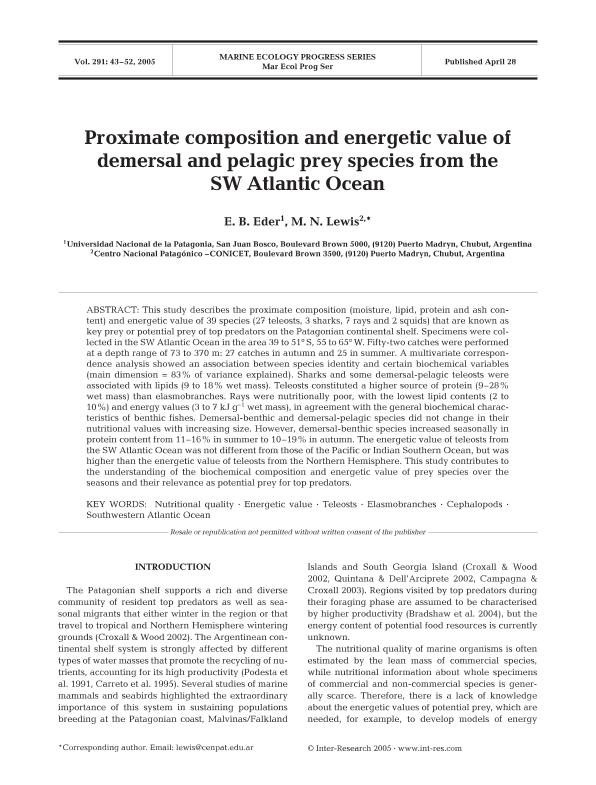Artículo
Proximate composition and energy value of demersal and pelagic prey species from Southwest Atlantic
Fecha de publicación:
12/2005
Editorial:
Inter-Research
Revista:
Marine Ecology Progress Series
ISSN:
0171-8630
e-ISSN:
1616-1599
Idioma:
Inglés
Tipo de recurso:
Artículo publicado
Clasificación temática:
Resumen
This study describes the proximate composition (moisture, lipid, protein and ash content) and energetic value of 39 species (27 teleosts, 3 sharks, 7 rays and 2 squids) that are known as key prey or potential prey of top predators on the Patagonian continental shelf. Specimens were collected in the SW Atlantic Ocean in the area 39 to 51°S, 55 to 65°W. Fifty-two catches were performed at a depth range of 73 to 370 m: 27 catches in autumn and 25 in summer. A multivariate correspondence analysis showed an association between species identity and certain biochemical variables (main dimension = 83% of variance explained). Sharks and some demersal-pelagic teleosts were associated with lipids (9 to 18% wet mass). Teleosts constituted a higher source of protein (9–28% wet mass) than elasmobranches. Rays were nutritionally poor, with the lowest lipid contents (2 to 10%) and energy values (3 to 7 kJ g–1 wet mass), in agreement with the general biochemical characteristics of benthic fishes. Demersal-benthic and demersal-pelagic species did not change in their nutritional values with increasing size. However, demersal-benthic species increased seasonally in protein content from 11–16% in summer to 10–19% in autumn. The energetic value of teleosts from the SW Atlantic Ocean was not different from those of the Pacific or Indian Southern Ocean, but was higher than the energetic value of teleosts from the Northern Hemisphere. This study contributes to the understanding of the biochemical composition and energetic value of prey species over the seasons and their relevance as potential prey for top predators.
Archivos asociados
Licencia
Identificadores
Colecciones
Articulos(CCT-CENPAT)
Articulos de CTRO.CIENTIFICO TECNOL.CONICET - CENPAT
Articulos de CTRO.CIENTIFICO TECNOL.CONICET - CENPAT
Citación
Eder, Elena Beatriz; Lewis, Mirtha Noemi; Proximate composition and energy value of demersal and pelagic prey species from Southwest Atlantic; Inter-Research; Marine Ecology Progress Series; 291; 12-2005; 43-52
Compartir
Altmétricas




